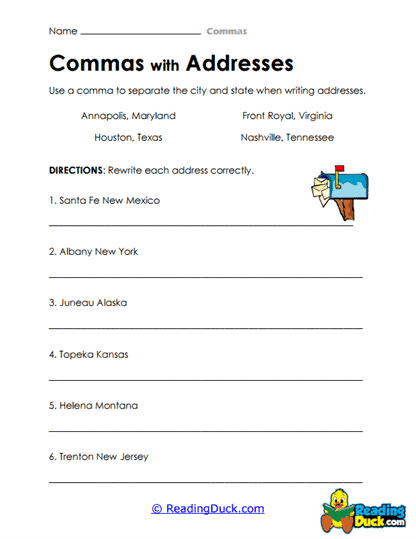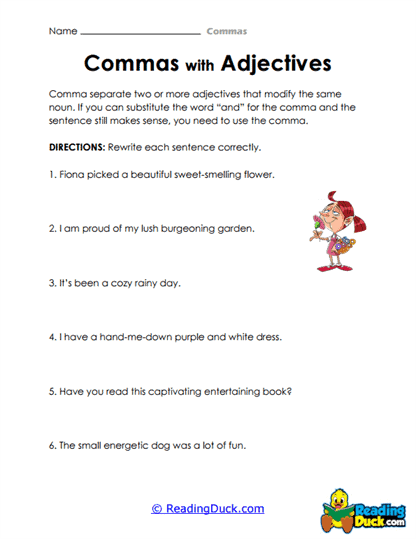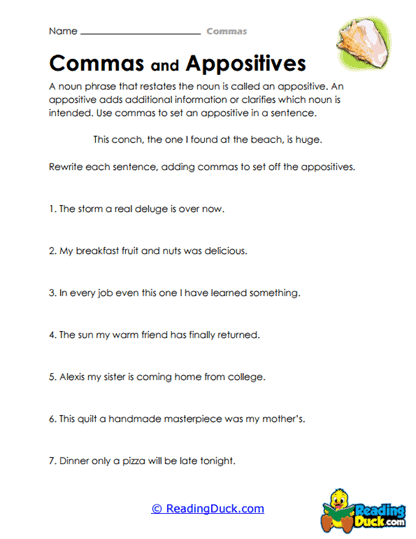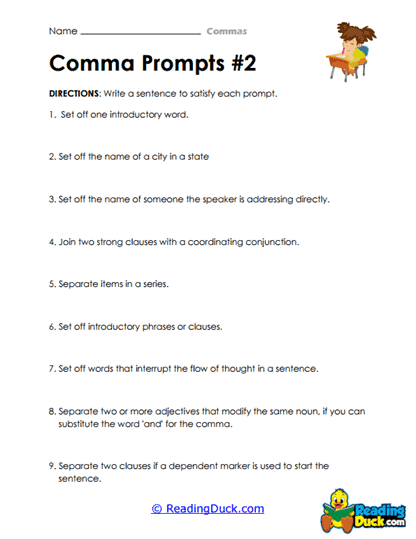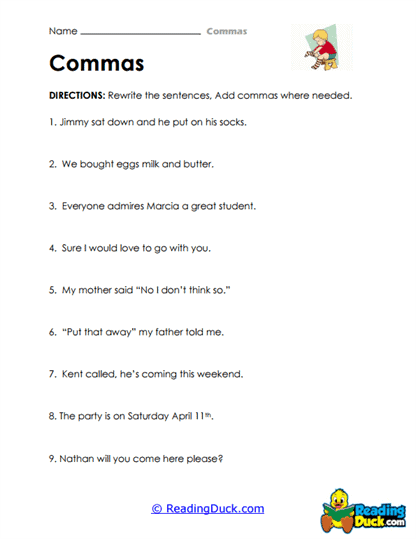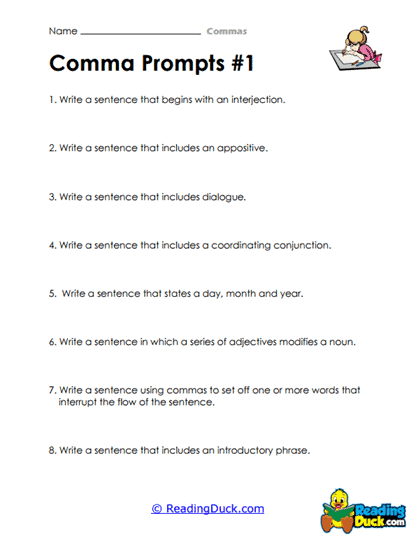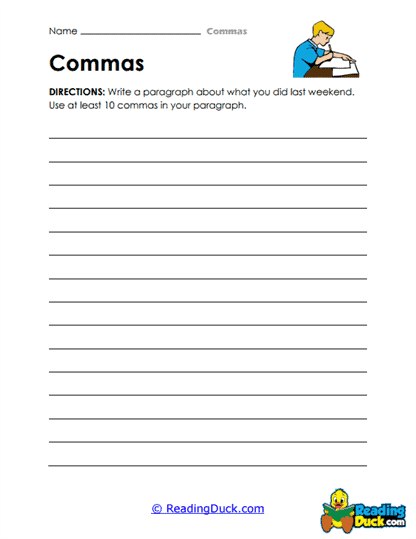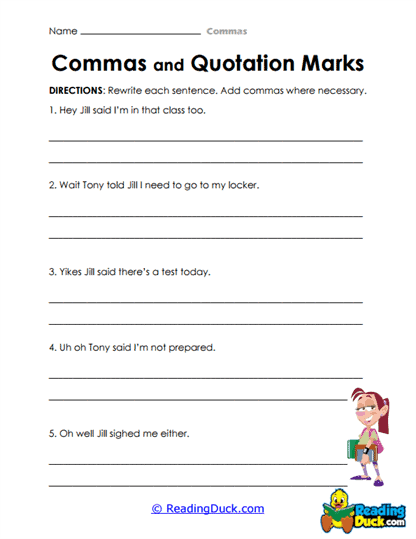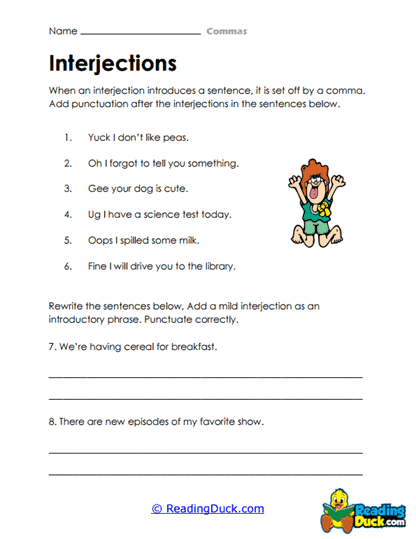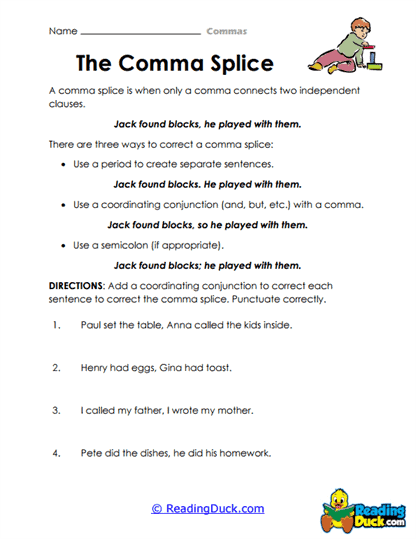Commas Worksheets
About Our Commas Worksheets
Our collection of Commas Worksheets provides a comprehensive tool for mastering the essential rules of comma usage, a fundamental aspect of punctuation. Falling under the Punctuation category within the Skills section, these worksheets guide students through the various contexts in which commas are used, helping them strengthen their writing and reading skills. Through well-structured exercises, learners will explore how commas bring clarity to writing, separate ideas, and organize sentences effectively. This collection helps students become more confident and skilled writers by providing practical applications of comma rules.
The worksheets are presented in a convenient PDF format, making them easy to view, download, and print, ensuring accessibility for both classroom and homeschool use. Each worksheet also includes a downloadable answer key, enabling students to assess their progress and allowing educators to provide immediate feedback, enhancing the overall learning experience.
What Are Commas? An In-Depth Look
Commas are one of the most commonly used punctuation marks in the English language, serving to organize and structure sentences. Their primary function is to separate elements within a sentence, making the writing more readable and preventing confusion. While commas might seem simple, their correct usage can be nuanced and varies depending on the context. Understanding commas is essential for clear communication, as they help break up ideas, clarify meaning, and ensure that sentences flow smoothly.
The Role of Commas in Writing
Commas serve several purposes in writing, and understanding these uses helps students become more effective communicators. By learning the rules surrounding commas, students can create sentences that are not only grammatically correct but also easier to understand.
Here are some of the key functions of commas:
Separating Items in a List: One of the most common uses of commas is to separate items in a series.
-
- Example: I bought apples, bananas, oranges, and grapes.
Introducing or Concluding Sentences: Commas are used to set off introductory phrases or to indicate when a sentence concludes with an additional clause.
-
- Example: After the movie, we went out for ice cream.
Breaking Up Independent Clauses: Commas can be used to separate independent clauses when they are joined by coordinating conjunctions such as "and," "but," or "or."
-
- Example: She wanted to go for a walk, but it started raining.
Setting Off Non-Essential Information: When a sentence includes extra information that isn't crucial to the meaning, commas help set this information apart.
-
- Example: My brother, who lives in New York, is visiting us next week.
Learning these key functions helps students understand the importance of commas in creating well-organized, clear, and grammatically correct sentences.
Exploring Different Uses of Commas
Commas play a crucial role in making sentences more readable and less ambiguous. However, their usage varies depending on the context of the sentence. Let’s explore some of the most important applications of commas and how they function in writing.
1. Commas in Lists
Commas are often used to separate items in a list, which helps to organize information and make it easier to read. The use of the serial comma (also known as the Oxford comma) before the final item in a list is optional but can clarify meaning, especially in complex lists.
- Example: For breakfast, I had eggs, toast, and orange juice.
- Without the Oxford comma: For breakfast, I had eggs, toast and orange juice.
In some cases, leaving out the Oxford comma can lead to ambiguity, so its use is often recommended for clarity.
2. Commas with Coordinating Conjunctions
When combining two independent clauses into a single sentence, a comma is placed before the coordinating conjunction (such as "and," "but," "or," "nor," "for," "so," or "yet").
- Example: I wanted to stay home, but I had to attend the meeting.
This rule helps to separate complete thoughts, making the sentence easier to understand.
3. Setting Off Non-Essential Clauses
Commas are used to set off non-essential information, which provides additional details without altering the core meaning of the sentence. These clauses are also called non-restrictive clauses.
- Example: My friend, who is a talented painter, won the art competition.
In this case, the non-essential information ("who is a talented painter") is separated by commas because it simply adds extra information, not necessary for understanding the main idea of the sentence.
4. Commas After Introductory Phrases
Commas are placed after introductory words, phrases, or clauses to separate them from the main part of the sentence.
- Example: After the concert, we went out for dinner.
These commas help signal that the introductory information is complete, and the reader should now focus on the main clause of the sentence.
5. Commas with Direct Address
When directly addressing someone in writing, commas are used to separate the person’s name from the rest of the sentence.
- Example: John, could you pass the salt?
This rule helps clarify who is being addressed and ensures the sentence flows naturally.
6. Commas in Dates and Addresses
Commas are used in dates and addresses to separate different parts, ensuring readability and clarity.
- Example (Date): He was born on July 4, 1990, in Boston, Massachusetts.
- Example (Address): Send the letter to 123 Maple Street, Springfield, Illinois.
By separating dates and addresses into their components, commas help prevent confusion.
Commas and Literacy Skills: Why They Matter
Commas play a crucial role in literacy development. Proper punctuation improves reading comprehension, writing fluency, and overall communication skills. Understanding when and how to use commas helps students become more proficient in both reading and writing, as punctuation provides necessary structure to the flow of ideas.
Enhancing Writing Clarity
Using commas correctly allows students to create clear, well-organized sentences. It helps them avoid run-on sentences and ensures that their ideas are presented in a logical and easy-to-follow manner. By breaking up sentences into manageable parts, commas help writers express their thoughts more precisely, improving the quality of their written communication.
Improving Reading Fluency
When students understand commas, they become more fluent readers. Commas provide important pauses and breaks in text, helping readers process information more effectively. Learning to recognize and interpret these breaks allows students to read more smoothly and with better comprehension.
Strengthening Communication Skills
Learning to use commas correctly not only improves writing skills but also enhances speaking and listening abilities. The natural pauses that commas introduce in text mirror the rhythm of spoken language, helping students develop a more natural and structured way of expressing their ideas.
Fun Activities to Reinforce Comma Usage
Educators can make learning about commas engaging and interactive by incorporating a variety of activities that reinforce what students learn in these worksheets. These activities are suitable for various grade levels and can be adapted for use in classrooms or homeschool settings.
Activities for Elementary Grades (Grades 3-5)
- Comma Placement Game: Create a series of sentences with missing commas, and ask students to place the commas in the correct locations. This activity can be turned into a fun challenge or competition to encourage participation.
- Create Your Own List: Ask students to write sentences that include lists of items, ensuring they correctly use commas. This activity helps them practice one of the most common uses of commas in a hands-on way.
Activities for Middle School (Grades 6-8)
- Sentence Transformation: Provide students with a paragraph without commas and ask them to insert commas where appropriate. This exercise helps them apply their knowledge in real-world contexts and understand the impact of punctuation on meaning.
- Comma Scavenger Hunt: Ask students to find examples of commas in their reading materials. They can then explain why the commas were used in those particular sentences, helping them apply their understanding of comma rules to real texts.
Homeschool Activities
- Family Comma List: In a homeschool setting, ask students to create lists of favorite family activities or members, ensuring they use commas correctly. This makes learning personal and relevant to their lives while reinforcing comma rules.
- Comma Challenge: Have students rewrite sentences they find in books or articles without commas, then add them back in correctly. This activity sharpens their editing and punctuation skills.
The Practical Significance of Comma Mastery
Commas are a critical tool for clear communication. By mastering comma usage, students learn how to structure their writing effectively, making it easier for readers to understand their ideas. Our Commas Worksheets offer a comprehensive resource for practicing and refining this important skill, providing opportunities for students to apply punctuation rules in various contexts.
Through consistent practice and reinforcement, students will become proficient in the use of commas, ensuring their writing is not only grammatically correct but also clear, concise, and engaging. This ability to punctuate properly will serve them well throughout their academic journey and in future professional writing endeavors.
